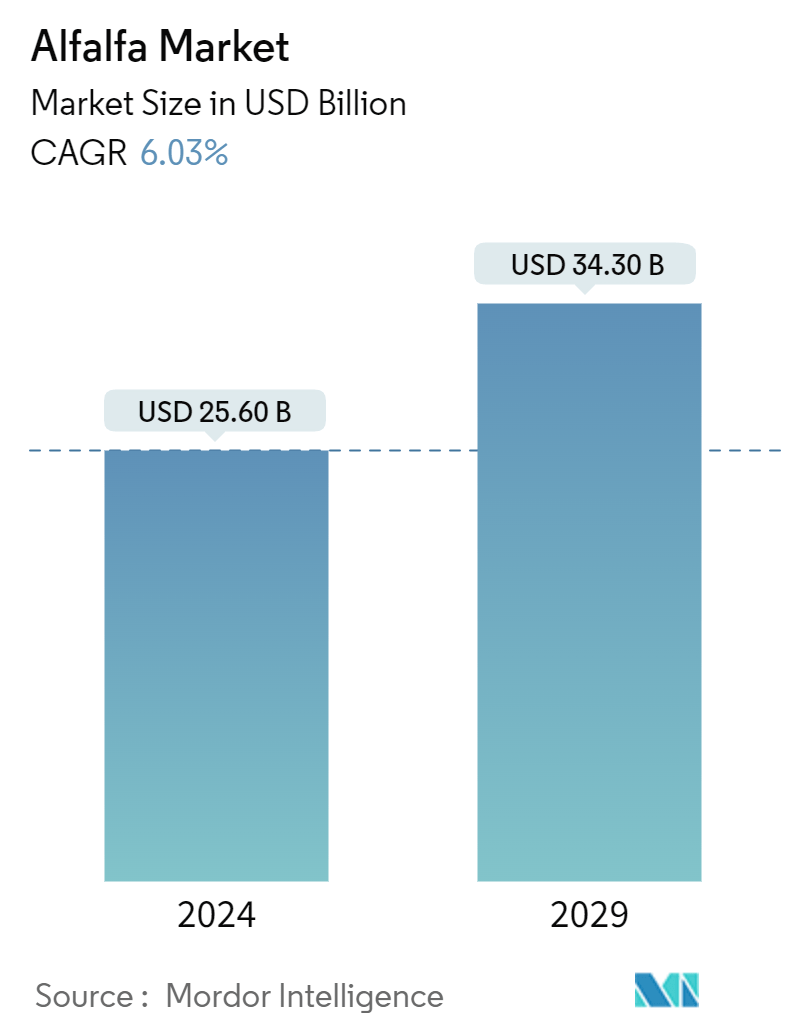Market Size of Alfalfa Industry

| Study Period | 2019 - 2029 |
| Market Size (2024) | USD 25.60 Billion |
| Market Size (2029) | USD 34.30 Billion |
| CAGR (2024 - 2029) | 6.03 % |
| Fastest Growing Market | Asia-Pacific |
| Largest Market | North America |
Major Players*Disclaimer: Major Players sorted in no particular order |
Alfalfa Market Analysis
The Alfalfa Market size is estimated at USD 25.60 billion in 2024, and is expected to reach USD 34.30 billion by 2029, growing at a CAGR of 6.03% during the forecast period (2024-2029).
Alfalfa, a perennial forage crop, is renowned for its rich protein content and abundance of vitamins A, K, and E, along with essential minerals. Its adaptability to diverse climates and soil types has led to its widespread cultivation across more than 80 countries, covering an area of 30 to 35 million hectares, according to the Crop Trust. The alfalfa market is primarily driven by the escalating demand for high-quality hay to feed the growing livestock and cattle populations, fluctuations in alfalfa hay prices, and the competitive pricing of alternative feeds and forages. In recent years, alfalfa hay has become increasingly vital in poultry nutrition and, subsequently, in general animal feed, owing to its significant crude protein content. Notably, the United States and Argentina are the major alfalfa-producing countries in the world.
North America is set to dominate the alfalfa market. Key importers of alfalfa hay from the United States include China, the United Arab Emirates, and Saudi Arabia. On the global stage, the United States and Spain stand out as the primary exporters of alfalfa. For instance, according to the USDA, in 2023, the United States exported 898,186 metric tons of alfalfa hay to China, accounting for 89.9% of China's total alfalfa imports, with a value of USD 461.7 million. South Africa surpassed Spain and became the second-largest exporter of alfalfa to China. South Africa's alfalfa exports reached 44,427 metric tons, while Spain's stood at 37,226 metric tons. The increasing demand for dairy and animal products, shrinking of the land for grazing animals, and growth in high-yielding cattle, as well as bred cattle demand for feed, are driving the alfalfa market globally.
Alfalfa Industry Segmentation
Alfalfa is also known as Lucerne and Medicago Sativa. It is cultivated as an important forage crop used for grazing, hay, and silage, as well as a green manure and cover crop. The alfalfa market is segmented by Geography (North America, Europe, Asia-Pacific, South America, and Middle East and Africa).
The report offers production analysis (volume), consumption analysis (value and volume), import market analysis (value and volume), export market analysis (value and volume), and price trend analysis.
The report offers market size and forecasts in terms of value (USD) and volume (metric tons) for all the above segments.
| Geography (Production Analysis by Volume, Consumption Analysis by Volume and Value, Import Analysis by Volume and Value, Export Analysis by Volume and Value, and Price Trend Analysis) | |||||||
| |||||||
| |||||||
| |||||||
| |||||||
|
Alfalfa Market Size Summary
The alfalfa market is poised for significant growth over the forecast period, driven by increasing demand from the livestock sector, particularly in dairy and meat production. The market is influenced by the rising need for quality hay to support the expanding cattle population and the growing reliance on alfalfa for poultry and animal feed due to its high crude protein content. Alfalfa's resilience to environmental stresses such as drought and heat further enhances its appeal as a reliable feed source. North America is expected to dominate the market, with the United States and Spain leading in global exports. Meanwhile, countries like China, the United Arab Emirates, and Saudi Arabia are major importers, reflecting the global demand for alfalfa hay.
In Asia-Pacific, the alfalfa market is experiencing robust growth, particularly in China, where government initiatives and changing production practices in the dairy industry are boosting demand. The Chinese government's efforts to increase domestic alfalfa production, alongside the rising number of dairy cows, are key factors driving this demand. Similarly, Japan and South Korea are significant markets for alfalfa hay, with imports growing to meet their forage needs. The shift in consumer lifestyles towards higher meat consumption is also contributing to the expansion of livestock farming, thereby supporting the alfalfa market's growth in the region.
Alfalfa Market Size - Table of Contents
-
1. MARKET DYNAMICS
-
1.1 Market Overview
-
1.2 Market Drivers
-
1.2.1 Increasing Demand For Dairy and Meat Products is Fueling the Market's Growth
-
1.2.2 Increasing Industrial Livestock Production is Boosting the Market
-
1.2.3 Shrinking of the Land for Grazing Animals
-
-
1.3 Market Restraints
-
1.3.1 Rising Costs of Inputs is Limiting the Market
-
1.3.2 Requirement of Large Quantities of Water for Irrigation
-
-
1.4 Value Chain/Supply Chain Analysis
-
-
2. MARKET SEGMENTATION
-
2.1 Geography (Production Analysis by Volume, Consumption Analysis by Volume and Value, Import Analysis by Volume and Value, Export Analysis by Volume and Value, and Price Trend Analysis)
-
2.1.1 North America
-
2.1.1.1 United States
-
2.1.1.2 Canada
-
2.1.1.3 Mexico
-
-
2.1.2 Europe
-
2.1.2.1 France
-
2.1.2.2 Spain
-
2.1.2.3 Italy
-
-
2.1.3 Asia-Pacific
-
2.1.3.1 China
-
2.1.3.2 Japan
-
2.1.3.3 Australia
-
2.1.3.4 South Korea
-
2.1.3.5 India
-
-
2.1.4 South America
-
2.1.4.1 Brazil
-
2.1.4.2 Argentina
-
-
2.1.5 Middle East and Africa
-
2.1.5.1 South Africa
-
2.1.5.2 Saudi Arabia
-
2.1.5.3 United Arab Emirates
-
2.1.5.4 Egypt
-
-
-
Alfalfa Market Size FAQs
How big is the Alfalfa Market?
The Alfalfa Market size is expected to reach USD 25.60 billion in 2024 and grow at a CAGR of 6.03% to reach USD 34.30 billion by 2029.
What is the current Alfalfa Market size?
In 2024, the Alfalfa Market size is expected to reach USD 25.60 billion.

